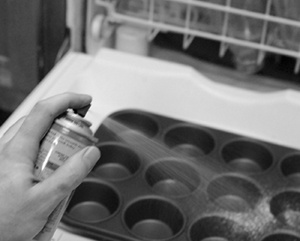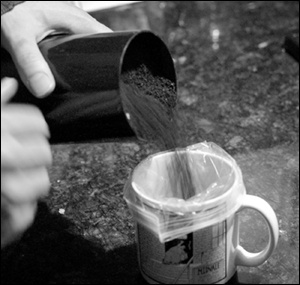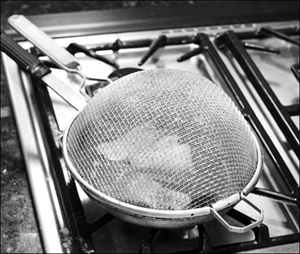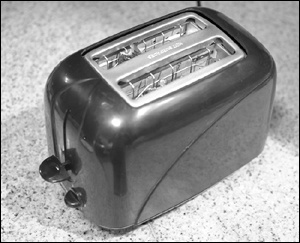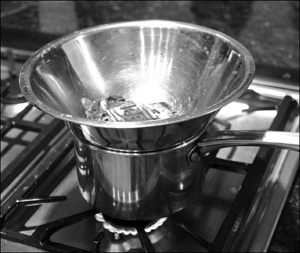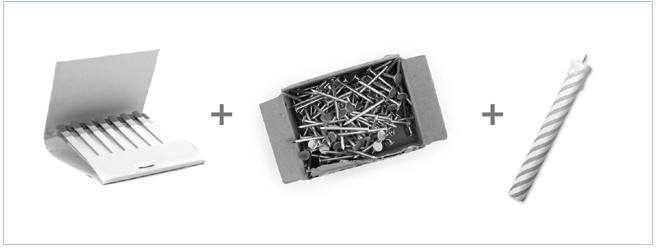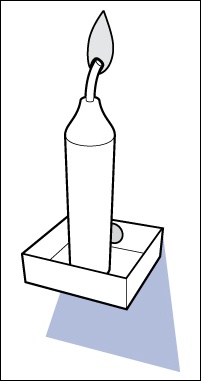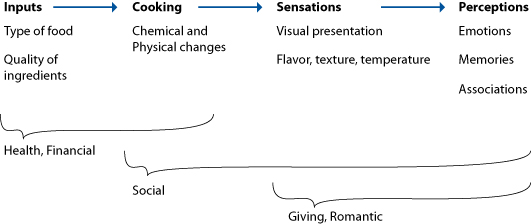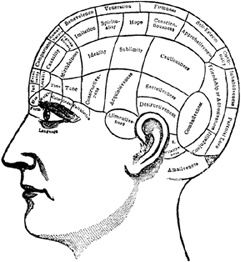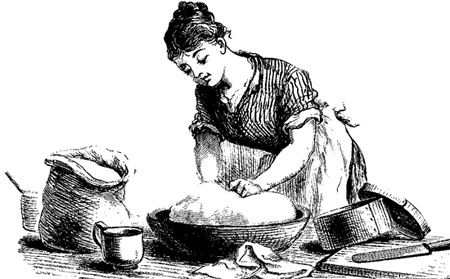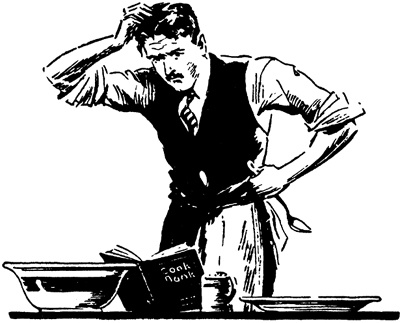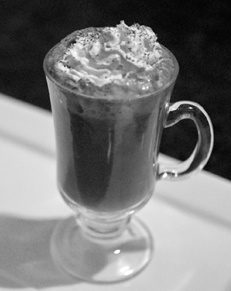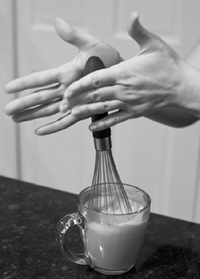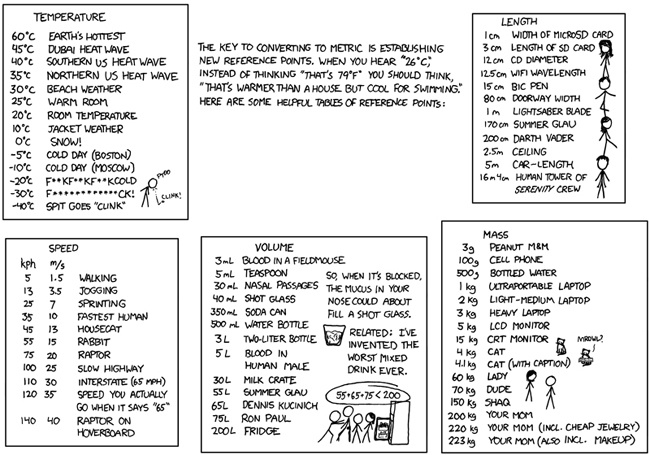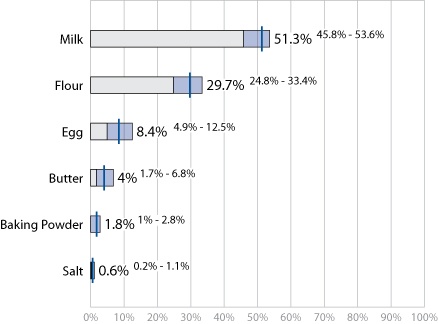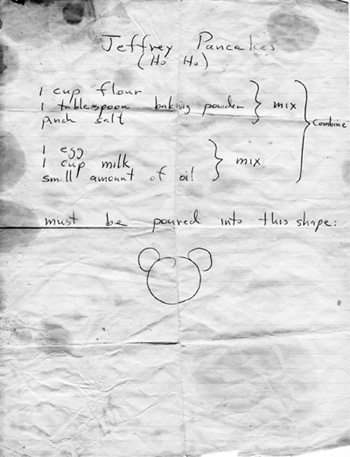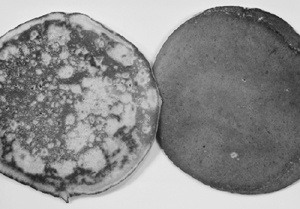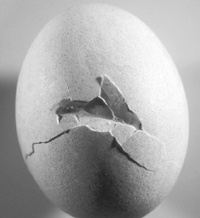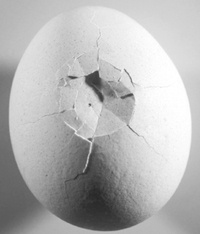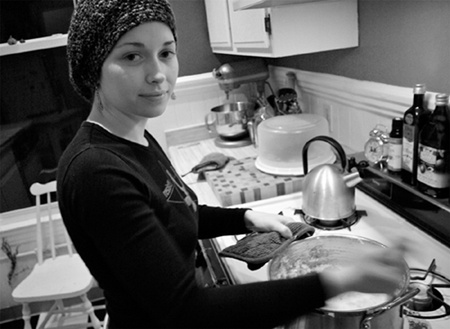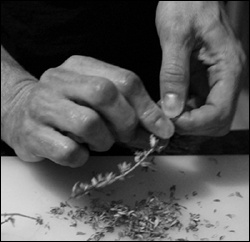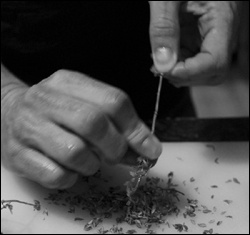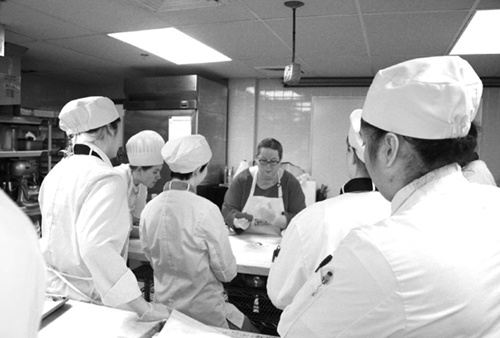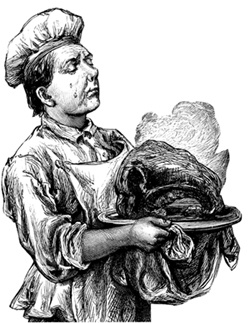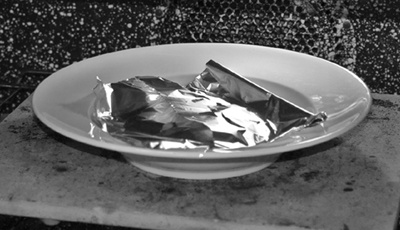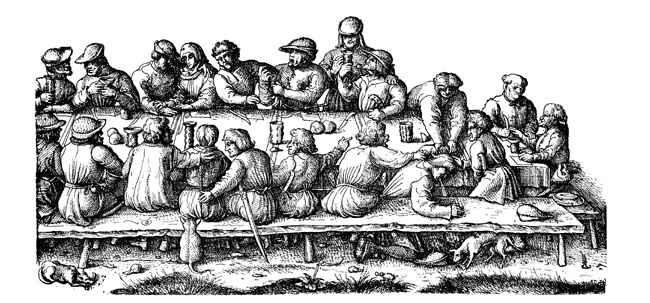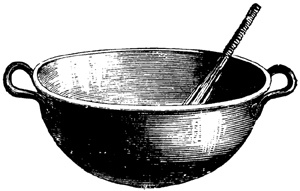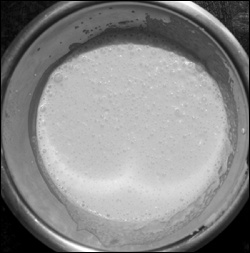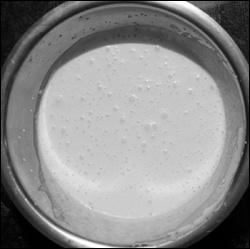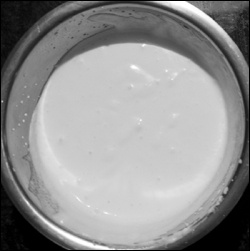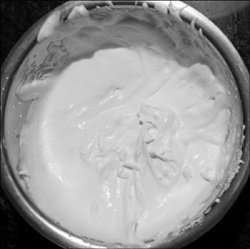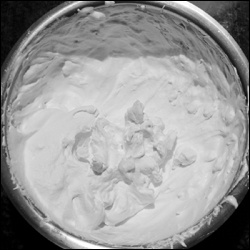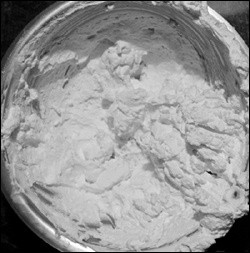Chapter 1. Hello, Kitchen!
WE GEEKS ARE FASCINATED BY HOW THINGS WORK, AND MOST OF US EAT, TOO.
The modern geek is more than just a refined version of the stereotypical movie geek from the ’80s. True, there’s a contemporary equivalent, who have swapped Star Wars posters, pocket protectors, and large glasses held together by tape for really, really smart phones, hipster glasses, and social websites running on virtual machines. The Internet has given the computer geek a new challenge. For most of us techies, the largest obstacle in building something great has changed from a technical to a social one. The question is no longer can you build it, but will people want it? We’re becoming a different kind of community, one that has to relate to a half a billion Facebook users, Twitterers, and lolcats. (I can has cheezburger? See Simple Cheeseburger.)
But what it means to be a geek today can also be broader. Overly intellectual. Obsessed with details. Going beyond the point where a mainstream user would stop, often to the bemusement of those who don’t “get it.” Physics geeks. Coffee geeks. Almost-anything geeks. A geek is anyone who dwells with some amount of obsession on why something works and how to make that something better. And it’s become a badge of honor to be a geek.
At our core, though, all of us geeks still share that same inner curiosity about the hows and whys with the pocket-protector crowd of yesteryear. This is where so many cookbooks fail us. Traditional cookbooks are all about the what, giving steps and quantities but offering little in the way of engineering-style guidance or ways of helping us think.
Unfortunately, there’s no way (yet) to download a program for kitchen techniques and experience straight into your brain. Don’t expect to walk away after finishing this book (or any other) knowing how to make a perfect four-course meal. That’d be like saying, “Hey, I want to learn how to program, so maybe I should start by writing my own operating system!”
But don’t despair. Learning to cook is not so much about rote memorization or experience as it is about curiosity, and that’s something us geeks have way more of than your average “random.” With the right mindset and a few “Hello, World!” examples, you can crack the culinary code and be well on your way to having a good time in the kitchen.
In this first chapter, we’ll cover how to approach the kitchen. What does it mean for a geek to hack in the kitchen? What things should a beginner keep in mind? What does success in the kitchen mean? How do you pick a recipe, and then how do you interpret it correctly?
We’ll also briefly touch on nutrition. If you’re already comfortable in the kitchen, you might want to skim this and the next chapter and dig right in with Chapter 3.
Think Like a Hacker
hack: 1. n. Originally, a quick job that produces what is needed, but not well. 2. n. An incredibly good, and perhaps very time-consuming, piece of work that produces exactly what is needed.
—Eric S. Raymond’s Jargon File
hacker: a person who delights in having an intimate understanding of the internal workings of a system, computers and computer networks in particular. The term is often misused in a pejorative context, where “cracker” would be the correct term.
—RFC1392, Internet Engineering Task Force
My microwave has no 3 key, but I can enter 2:60.
—As tweeted by Tom Igoe, @tigoe
Cooking has the same types of hard constraints that code, hardware, and most science disciplines do. Processes (chemical or virtual), reactions, allocation of resources (more veggies!), and timing all matter. And while each discipline has standard techniques for solving these constraints, invariably there are other clever alternatives. Hacks don’t have to be quick and dirty (that’d be a hack job), or overly involved works of perfection.
Some of the best hacks start out as safe and stable ways of
solving unexpected problems, and being able to see those solutions is
what it means to think like a hacker. It’s rare to see a hack called for
in a spec. Imagine a programmer coding a script that needs to count the
number of lines in a text file. Standard method? Open, read a line,
++, close. Five minutes until demo?
`wc –l "$file"`. While the hack is
easier and faster to write, you should probably understand
open/read/close first and know how and when to use them.
If you’re new to the kitchen, buckle down and be prepared to learn the system from the inside out before breaking out the blowtorch, methylcellulose, or centrifuge. Every one of the well-respected chefs and instructors interviewed for this book has a thorough grasp of the fundamentals of cooking. Those who use tools like centrifuges and ingredients like methylcellulose use them as ways of extending those cooking fundamentals, not merely for the sake of novelty. To the pros, these newer techniques and ingredients simply expand their repertoires, taking their place alongside olive oil, flour, and other pantry staples.
What does it mean to take the hacking mindset into the kitchen? Sometimes it’s technique. Rolling pizza or pie dough to a uniform thickness by eye can be tricky, but slap a few rubber bands on each end of the rolling pin, and you’ve got an instant guide. Need to pour spices or coffee grinds into a plastic bag? Drop the plastic bag in a mug or cup and fold the edge of the bag over the edge. “Hacking” can apply to the ingredients as well, as you’ll see in Chapter 3.
Ways of doing things become obvious once you see them. The challenge in the kitchen is to see where you want to go and then find a path that gets you there. Thinking like a hacker means thinking of an end state and then figuring out how to get there in a time- and space-optimal (and fewest-dishes-possible) way.
How does one go about discovering hacks and tricks in the kitchen? Here’s a thought experiment: imagine you’re given a candle, a book of matches, and a box of nails, and asked to mount the candle on a wall. Without burning down the house, how would you do it?
Functional Fixedness
The problem just described is called Duncker’s Candle Problem, after Karl Duncker, who studied the cognitive biases that we bring to problems. In this example, things like the paper of the matchbook have a “fixed function” of protecting the matches. We don’t normally think of the matchbook cover as a piece of thick cardboard that’s been folded over; we just see that as part of the matchbook. Recognizing the object as capable of serving other functions requires mental restructuring, something that the scriptwriters for MacGyver excelled at.
This mental restructuring is something that most geeks are naturally good at. All those interview puzzles common in the tech industry? You know: how would you start a fire with a can of soda and bar of chocolate?[1] Or, you’re given 12 gold coins and a balance scale, but wait! One of the coins is fake, either lighter or heaver than the others, and the balance scale will magically break after exactly three uses. Problems like these almost invariably come down to breaking functional fixedness and overcoming confirmation bias (here, in the sense of being blinded to new uses by knowing previous uses). The obvious solutions to the candle problem—pushing the nails through the candle or melting the candle so that it sticks to them—will either split the candle or leave it too close to a wall to be safe. The solution, or at least the one Duncker was looking for, involves repurposing the box that had been holding the nails into a shelf. (I’m dreading all the emails I’m going to get with photos of this being done in other ways.)
Approaches for overcoming functional fixedness in puzzles, code, or the kitchen are the same. Understand what you actually have and what you’re asked to do, break it down into individual steps, and explore different possibilities for each discrete step. Take the quest for the perfect cup of coffee: can you isolate the variables for bean grind, temperature, pressure, etc. and then explore the combinations in a controlled way, varying just one variable at a time? Think about the ingredients you’re starting with and the end state you want, as opposed to the straight execution of a recipe. This way, when the execution inevitably veers off course, you can understand the step you are at and how to catch and correct the exception. Of course, be open to other possible outcomes—the way a meal turns out will sometimes be different than what you originally conceived.
Thinking about the end state will also help broaden how you think about cooking more generally. Cooking is not just about food in a pan; it’s about health and well-being, community and giving. Why do you want to cook? Watching your waist or your wallet? Health and finances are common considerations. Building community? Potlucks, shared meals, and barbeques can be fun social activities and even spur friendly competition. Expressing love? Cooking can be an act of giving, both in the literal sense of sustenance and in the spiritual sense of sharing time and breaking bread together.
Cooking also allows you to try new things—there are plenty of foods that you can’t order in a restaurant. Perhaps you want to get closer to your source of food, in which case learning how simple it can be to put together many common dishes will bring you at least one step closer. And then there’s getting yet another step closer: I happen to eat meat, but what I buy at the store is so far removed from a living, breathing animal that I find it hard to identify with the life of the critter. (The English language doesn’t help. We eat beef, but it’s a cow. We eat pork, but it’s a pig. Chickens don’t seem to be smart enough to merit a clear separation.) To properly respect an animal’s life, to understand where my food comes from and to be mindful of not wasting it, I feel that at some point I should have to butcher an animal myself. (You could try lobster, but I’ve yet to get teary-eyed over one.) For me, cooking is also as much about escaping from work as it is about satisfying hunger, not to mention having fun trying new things with friends and knowing that what I’m putting in my body is healthy.
Regardless of your reason for wanting to cook, realize that there’s more to cooking than just following a recipe. When looking at the end goal, think beyond the cooking stage. If your reason for cooking is to express affection, you should consider the sensations that your food brings your guests and the perceptions and reactions they have to it as much as the cooking itself. On the other side, if you’re cooking primarily for health or financial reasons, the quality and price of ingredients will be much more important.
If your goals are social, the end state isn’t the food on the plate; it’s the perceptions that are brought about by the experience of eating. If you’re making a meal for a romantic interest, give thought not just to the work done in cooking, but also the experience at the table. While you can’t control your guest’s perceptions, you do have control over the inputs, cooking, and sensations, all of which inform and shape those perceptions. Even something as simple as preheating your plates so that hot food remains hot can make an impact. (Cold sautéed fish and vegetables? Yuck.) For some, the extra effort of setting the table with nice flatware or festive plates can be a powerful signal of attention and affection.
Here’s a way of thinking about this visually:
We’ll cover the first column of the stages and reasons for cooking diagram, Inputs, in Chapter 3 and give Cooking its due respect in Chapter 4 and Chapter 5. Some elements from the final two columns, Sensations and Perceptions, are covered indirectly in Chapter 6 and Chapter 7, since playing with textures and presentations is a great way to evoke memories. But the essence of sensations and perceptions is much more in the personal domain. If your reasons for cooking include being social, giving, and romantic, consider how to draw upon these aspects as you try things from this book.
Finally, for those who say presentation doesn’t matter, think about dining-hall food, and then check out Fancy Fast Food (http://www.fancyfastfood.com). How we approach food, from a food psychology and consumer behavior perspective, impacts our experience much more than we are typically willing to admit, even when confronted with hard data. See the interview with Brian Wansink on the next page for a story about his graduate students and Chex Mix to get a sense of just how far this denial goes!
A Few Words on Nutrition
Most of this book deals with cooking for pleasure and enjoyment, but at the end of the day, it does come down to making sure your body has the nutrients it needs to keep you going and to keep you healthy. Okay, okay; I know... You probably don’t want yet another rant on how you should be eating more veggies. I promise to keep it short.
While our bodies are amazingly adaptive systems, able to tolerate just about anything in the short term, the general consensus is that you’ll be happier, healthier, and live longer if you eat the right things. What’s “right” isn’t the same for everyone, since genetics, metabolisms, and activity levels differ so much. Nor is it easy to prescribe an exact diet, a “perfect” diet, because the human body seems to adapt so well. Just talk to anyone who’s tried to lose weight. The human body can adapt to a wide range of eating patterns. After all, we have evolved to survive under less-than-ideal situations. There’s even a New York Times article about one guy who lives primarily on candy, and it seems to work for him!
Still, there are two general rules for nutrition that you should keep in mind: eat the right amount and eat healthy foods. Portion control is a big issue for many Americans, especially as restaurant meals tend to be way larger than they need to be. And it’s easy to plop down on the couch in front of the TV and eat away. You should eat until you’re just full, not until you’re stuffed or your plate is empty. And while there’s no perfect list of foods, you should eat “whole” foods—grains, vegetables, fish, and moderate amounts of meats—and restrict the amount of processed foods, especially those high in sugar, fats, and salt. Personally, I believe eating foods that would have been recognized a century ago is a good rule of thumb.
We eat for two physiological reasons: to provide our bodies with food to break down into energy (via catabolism), and to provide our cells with the necessary building blocks to synthesize the chemicals that cells need to function (called anabolism). At the simplest level, there are macronutrients (proteins, fats, and carbs) and micronutrients (trace elements, vitamins). Both provide the chemical compounds that your body needs for anabolism, but it’s the macronutrients that provide the energy necessary to read, grocery shop, and cook. As long as you’re ingesting enough (but not too much) of each type of nutrient, your body will be good to go. If you’re regularly cooking balanced meals for yourself, you probably don’t need to worry too much about micronutrients.
When it comes to measuring the amount of energy in food, the standard unit of measurement used in the United States is the food calorie, equal to 1,000 gram calories (the amount of energy needed to heat 1 gram of water by 1°C). In nutrition, “food calorie” is sometimes capitalized to “Calorie” to distinguish it from a gram calorie and is abbreviated as kcal or C. (Other parts of the world use joules and kilojoules.) How many calories your body needs depends upon both your body’s base caloric requirements and your activity level. If you’re a desk jockey, you’re probably not burning as many calories as a student running back and forth between classes and the lab. If you routinely eat more calories than your body burns, your body will convert the excess calories into fat, even if the source of those calories wasn’t fat. (Sugary fast-food items labeled “low fat” are not “low fattening.”) Eat too few calories, and your body will either lose weight or slow down your metabolism; that is, slow down the rate of chemical reactions related to anabolism and catabolism, leaving you with less energy. Eat far too few calories for an extended period of time and your body will suffer from malnutrition.
While a calorie is a calorie in the sense of energy, the food you ingest isn’t just about energy. Your body needs various types of nutrients for specific purposes. Protein, for example, provides essential amino acids necessary for building and repairing muscle. If you ate only carbs, you wouldn’t last long! Unless you have particular dietary needs—say, for athletic training or pregnancy—you’re probably getting sufficient quantities of proteins and fats.
Not all fats are created equal, nor are all carbs the same. As a general rule, you want your fats to be liquid at room temperature (good: olive oil, canola oil; bad: lard, shortening), and you want your carbs to not be white (that is, cut down on white rice, white flour, and sugar). As with so many things in food, it’s the dosage that matters. A little bit of salt won’t hurt you; too much will kill you. Avoid processed foods as much as possible. Most processed foods are engineered for consistency and shelf stability, which usually results in trade-offs of nutritional benefit. Even white flour has its drawbacks: the wheat germ and bran are removed (the oils located in the germ and bran go rancid, so removing them extends shelf life), but the germ and bran are beneficial to our health. Still, if your body needs calories, processed food is better than no food, and the occasional brownie isn’t going to hurt.
If all of this still leaves you wondering what to cook for dinner, consider what Michael Pollan wrote in the New York Times (“Out of the Kitchen, Onto the Couch,” August 2, 2009):
I asked [food-marketing researcher Harry Balzer] how, in an ideal world, Americans might begin to undo the damage that the modern diet of industrial prepared food has done to our health.
“Easy. You want Americans to eat less? I have the diet for you. It’s short and it’s simple. Here’s my diet plan: Cook it yourself. That’s it. Eat anything you want—just as long as you’re willing to cook it yourself.”
Tips for Newbies
Knowing how to overcome functional fixedness problems such as Duncker’s Candle Problem requires understanding how to read a recipe and break it down into the individual steps, so that you can control and vary the discrete stages. As with any protocol, understanding the structure is critical; you have to understand a system before you can hack it. Here are a few tips for getting yourself in the right state of mind to learn the kitchen equivalents of programming’s “open, read, close”:
Have fun! Learning is about curiosity, not work.
Know your type. Like to grill? Then grill. Rather bake? Then bake.
Read the whole recipe before starting, and make sure you understand each step.
Take time to taste things, both to adjust seasoning and to learn how the taste changes during cooking.
Don’t be afraid to burn dinner!
Have fun!
I was talking with a friend of mine, a fellow geek who was just starting to learn to cook, when he said:
I was never that curious about cooking, so I thought that buying The Joy of Cooking and going through it would be the right approach. That’s probably like sitting down with Donald Knuth’s The Art of Computer Programming in order to learn to program, when really all you should be doing at first is trying to make something you like.
He’s right: make something you like, give yourself enough time to enjoy the process, and have fun doing it. Slaving through the Joy or Knuth will work, but it’s not the way most people learn to cook or write code. It’d be like picking up a dictionary to learn how to write. The culinary equivalent of The Oxford English Dictionary or The Art of Computer Programming is Harold McGee’s On Food and Cooking (Scribner). It’s a fantastic reference and a substantial contribution to our understanding of the everyday processes in food, and you should make space for a copy on your bookshelf. But it is not a book for learning how to cook.
If there’s one secret about learning how to cook, it’s this: have fun in the kitchen. Go experiment. Play. Take that hacker curiosity that you use in front of the keyboard and bring it with you into the kitchen, to the grocery store, and on your next meal out. Cook to please yourself. Doing someone else’s work is nowhere near as much fun as working on your own projects, and it’s no different in the kitchen: pick something you want to learn how to cook and try making it.
Caught between two different ways of cooking something? Do an A/B test: make it one way, then a second way, and see which works better.
Don’t cook a new dish for an important guest. If you’re nervous about how it’ll turn out, cook for just yourself, so you don’t have to worry about trying to impress someone (especially a potential romantic interest!). It’s entirely okay to screw up and toss it in the trash; it’s no different than a programmer refactoring code. Most people’s first drafts of software, food, or books need refinement before they’re ready to ship. Sure, it’ll hurt a little on the wallet, but it’s not wasted: you did learn something, yes? Success!
Finally, don’t expect your cooking to taste exactly like restaurant or packaged foods. For one, a lot of commercial cooking is designed to appeal to the palette via a salty, fatty, or sugary assault on the senses. Tasty? Yes. Healthy? Not exactly. Learning to cook is a great way to control what you eat and, by extension, your health.
Know your type
There are two kinds of people in the world: those who divide people into two kinds, and those who don’t. Or is it 10 types: those who know binary, and those who don’t? All joking aside, “binning” yourself into the right category will make the learning process a whole heck of a lot easier. And in case you’re the irreverent type who insists you don’t fit into any standard category, work with me here. Consider the following: vi or emacs? Windows or Mac? PHP or Python? Sure, you might not have strong preferences, but it’s still clear that divisions exist.
The culinary world has its divisions, too. The biggest one in the professional world is that of cooks versus bakers. Cooks have a reputation for an intuitive, “toss it into the pot” approach, adding a pinch of this or a dash of that to “course-correct” along the way. Bakers are stereotypically described as precise, exact in their measurements, and methodically organized. Even culinary schools such as Le Cordon Bleu split their programs into cooking (“cuisine”) and baking (“patisserie”). But this is probably due to the differences in technique and execution. Cooking is split into two stages: prep work and then an on-demand, line-cook portion. Pastry and baking is almost always done production-style, completed in advance of when the order comes in.
This isn’t to say that professional cooks hate baking, or that bakers don’t enjoy cooking. But if you find yourself dipping your finger into the cake batter and being tempted to add more of this or that, pay attention to what it means. If you’re the type who really likes to have an exact set of instructions to follow, taking the guesswork out of the process, learn to relax and develop your kitchen instincts when whipping up a dinner. Give yourself permission to dislike some parts of cooking. For most of us, it’s a hobby, not a profession, so it’s okay to skip the culinary equivalent of documenting your code.
Avoid PEBKAC-type errors: RTFR!
Avoid Problem Exists Between Knife And Chair–type errors by Reading The F’ing Recipe! Recipes are code, although they require some interpretation, so read the recipe, top to bottom, before starting. One interviewee, Lydia Walshin, explains:
The biggest, biggest piece of advice that I can give any cook starting out, and even a lot of experienced cooks, is to take a minute, breathe deeply, read the recipe first, and know from the beginning where you think you want to end up. Don’t start out thinking you’re making a soup and halfway through you find out you’re making a stew, because it’s a recipe for disaster.
Every. Word. Matters. I’ve watched geeks with PhDs in chemistry skip right over steps that say “turn off heat” in the middle of a recipe that involves melting chocolate in simmering port. Turn off heat? But melting things requires heat! In fact, the residual heat from the port will melt the chocolate, and this way you don’t accidentally burn it.
It’s okay to go “off recipe.” In fact, it’s a great way to learn; just do it intentionally. Maybe you don’t have all the ingredients and want to substitute something else. Perhaps the recipe is poorly written or has errors. Or, as in programming, you can see there’s more than one way to do it and you want to do it differently. A recipe isn’t a strict protocol, but do understand the suggested protocol before deviating.
There’s a lot of room for personal preference in cooking. Just because a recipe for hot chocolate might say “½ cup heavy cream, 1 cup milk,” that doesn’t mean you must use those quantities. As another interviewee put it, “Please, let’s get off the recipes!” I couldn’t agree more. If you’re following a recipe and think it needs more or less of something, or could benefit from an extra spice, go for it. I usually stick to the recipe the first time I make something, but after that, all bets are off. I’ll pull out a pencil, make notes, change quantities, drop and add ingredients. I encourage you to do that to this book! After making something, take a pencil and make notes as to what you’d do differently next time. That way, when you next pick up the book, you’ll remember how to tweak the recipe to your taste. (And if there are any errors in the text, you won’t repeat them.)
If a brownie recipe calls for walnuts, but you really like almonds, yes, it’ll still work! Out of vanilla extract? Those chocolate chip cookies will be fine. Your timer says the chicken has been in for the prescribed time, but it’s still got that gross, raw chicken look? Pop it back in the oven. (Better yet, use a probe thermometer, as explained in Thermometers and timers in Chapter 2.)
In most modern cookbooks, recipes are laid out in two sections: ingredients and methods. The ingredients section lists the quantities and prep steps for each of the ingredients, and the methods section describes how to combine them. Recipes in this book are laid out in a more conversational format that walks you through the recipes with ingredients listed as they come up. Pay attention to the notes, as they show where you can do things differently.
To get started, consider the recipe for hot chocolate on the following page.
The recipes in this book give both weight in grams and standard U.S. volume-based quantities. Sometimes, the weights are rounded up or down a bit. 1 cup milk, for example, actually weighs 256 grams (1 cup = 237 ml). We’ll cover when to use weight and when to use volume in Chapter 2, but be aware that the conversions given between the two are sometimes rounded for convenience’s sake.
What kind of milk? Whole milk? Skim? If a recipe doesn’t specify, it shouldn’t matter too much, although as a general rule I tend to split the difference and grab lowfat/semi-skimmed milk. Sometimes the choice is governed by taste preference, so if you’re used to that watery stuff or are the stick-of-butter type, go for it. Some cookbooks will specify defaults in their introductions, perhaps defining milk as whole milk. The most common generic term is flour. When it’s called for, you can assume that what you need is AP (all-purpose) flour. AP flour really isn’t all-purpose; it just has a moderate amount of gluten (10–12%) as compared to cake flour (6–8%) or bread flour (12–14%).
When a recipe calls for something “to taste,” add a pinch, taste it, and continue adding until you think it is balanced. What constitutes balanced is a matter of cultural background and personal preference for some ingredients, especially seasoning ingredients such as salt, lemon juice, vinegar, and hot sauce. There’s some evidence that some of these preferences are actually a matter of biological differences between the way different people taste, as discussed in Chapter 3.
f(g(x)) != g(f(x)) Translation? Order of operations is important! “3 tablespoons bittersweet chocolate, chopped” is not the same thing as “3 tablespoons chopped bittersweet chocolate.” The former calls for 3 tablespoons of chocolate that are then chopped up (taking up more than 3 tablespoons), whereas the latter refers to a measure of chocolate that has already been chopped. When you see recipes calling for “1 cup nuts, chopped,” measure the nuts, then chop; likewise, if the recipe calls for “1 cup chopped nuts,” chop the nuts and then measure out 1 cup.
Taste == Feedback
Learn to really taste things. The mechanical aspects of cooking—combining ingredients, applying heat—come down to smell and taste. Pay attention to your sense of smell and see if you can notice a change in the odors just as the food finishes cooking. Take time to taste a dish and ask yourself what would make it better. And taste things throughout the process of cooking to see how the flavors evolve over time.
One of the first things I was taught in painting class was to be comfortable scraping the still-wet oil paint off the canvas. We were told to paint a still life; a few hours later, our instructor said, “Great, now take the palette knife and scrape the paint off. All of it.” Talk about frustration! But it’s a good lesson: becoming attached to the current state of something prevents you from being able to see better ways of doing it. In writing, it’s called “killing your babies”: deleting favorite bits of the text that no longer serve their original purpose. (These are usually pieces of text that are older and have survived rewrites due to emotional attachment.) “Killing your babies” is about getting beyond the current version, about getting from point A to a better point: B.
How does all this relate to cooking? Given a sauce, stew, cookie dough, whatever food you’re working with, its “current state” is A. If you taste it and think it’s not quite right, how do you get to B? Start with A, taste it, take a guess at what might make it better, and try version B. Turning out great food isn’t about following a recipe exactly and getting it right on the first pass; it’s about making many small guesses and picking the better choice with each guess.
Try making a guess with a small side portion if you’re unsure. Making stew? Put a few spoonfuls in a bowl and season that. Making cookies? Bake just one cookie, see how it comes out, and tweak the dough before making the next one.
Sure, to be proficient at something you do need the technical skill to be able to see where you want to go and to understand how to get there. And happy accidents do happen. However, the methodical approach is to look at A, wonder if maybe B would be better, and rework it until you have B. (“Hmm, seems a bit dull, needs a bit more zing, how about some lemon juice?”) The real skill isn’t in getting to B, though: it’s in holding the memory of A in your head and judging whether B is actually an improvement. It’s an iterative process—taste, adjust, taste, adjust—with each loop either improving the dish or educating you about what guesses didn’t work out. Even the bad guesses are useful because they’ll help you build up a body of knowledge.
Taste the dish. It’s your feedback mechanism both for checking if A is “good enough” and for determining if B is better than A.
Don’t be afraid to burn dinner!
Talking with other geeks, I realized how lucky I was as a kid to have parents who both liked to cook and made time to sit down with us every day over a good home-cooked meal. Because of this background, approaching the kitchen has never been a big deal for me. But for some, the simple idea of stepping into the kitchen sets off panic attacks as the primitive parts of the brain take over (you can blame your brain’s locus coeruleus; it’s not your fault).
Here’s the thing. Failure in the kitchen—burning something, “wasting” money, and having to order pizza—is actually success. Think of it this way: there’s not much to learn when things work. When they fail, you have a chance to understand where the boundary conditions are and an opportunity to learn how to save something in the future when things go awry. Made mac ’n cheese from scratch but the sauce turned out gritty? Spend some time searching online and you’ll discover that gritty cheese sauce = “broken” sauce, which is caused by too much heat and stirring, or using nonfat cheese. The key to learning how to cook is to define success as a chance to learn rather than as a perfect meal. Even if dinner does end up in the trash, if you learned something about what went wrong, that’s success. Failure in the kitchen is a better instructor than success.
Fear of failure is another thoroughly modern American phenomenon. We’re bombarded with images of the perfect Thanksgiving turkey (they probably used a plastic one during the photo shoot), photos of models sporting impossible physiques (thanks, Photoshop), and stories of triumph and success (where they don’t disclose the sad parts and trade-offs). Then when we go to try something, we often find it doesn’t work for us the way it seems to for others. Setbacks. Negative feedback. No wonder there’s so much fear of failure: we’ve set ourselves a bar so high that it simply doesn’t exist.
There’s a generation of Americans hung up on being perfect. The perfect white teeth, the perfect clothing, the perfect “carefree” tossed-together wardrobe. Helicopter parents. Overly critical Yelp.com reviews that rag on everything, down to who cuts our hair and the food we eat. Insane expectations in reviews on Amazon.com about the books we read. (A good book is one that gives you more value than the cost of the book and your time. Be kind.;-) ) No wonder why some parts of American society seem to match the DSM-V criteria for schizophrenia: we’re literally going insane trying to be perfect when it just isn’t possible. It’s much easier to love yourself for who you are than to try to be perfect (the latter will never bring true happiness), and it’s much easier in the kitchen to aspire to “fun and tasty” than the perfect 16-course gourmet meal (although attempting it can be fun on occasion).
Be okay with being “just” good enough. Part of the appeal of Julia Child was her almost-average abilities and her “nothing special” aura. The reason some people fear Martha Stewart is because her cooking looks perfect and always comes out perfectly on the first try. (I have the world of respect for Ms. Stewart.) Given her background—starting a catering business out of her basement—she had to be perfect to succeed. (Wedding days have to be perfect, no?) This quest for perfection comes at a real cost, though; even if it’s achievable for a day, it isn’t practical day-in, day-out.
Set reasonable goals, and expect to get frustrated on occasion. Cooking well takes practice. Play around with various ingredients and techniques, and come up with projects you want to try. (Mmm, bacon and egg breakfast pizza.) It’s like learning to play the guitar: at first you strive just to hit the notes and play the chords, and it takes time to gain command of the basic techniques and to move on to the level where subtle improvisation and nuanced expression can occur. If your dream is to play in a band, don’t expect to get up on stage after a day or even a month; start by picking up a basic book on learning to play the guitar and practicing somewhere you’re comfortable.
A beta tester for this book commented:
While there are chefs with natural-born abilities, people have to be aware that learning to cook is an iterative process. They have to learn to expect not to get it right the first time, and proceed from there, doing it again and again.
What about when you fubar (foobar?) a meal and can’t figure out why? Think of it like not solving a puzzle on the first try. When starting to cook, make sure you don’t pick puzzles that are too difficult. Start with simpler puzzles (recipes) that will allow you to gain the insights needed to solve the harder ones. And give it time. You might have days when you feel like you’ve learned nothing, but the cumulative result will lead to insights.
If a recipe doesn’t work as well as you’d have liked, try to figure out why and then try it again. It might also be the fault of the recipe, or that the recipe is simply too advanced. I know some newbies who have gotten stuck trying to perfect one dish. They usually burn out in frustration. If you’re not happy with the results of your early attempts, try a different source of recipes. Some books, especially those from top-tier restaurateurs such as Chefs Thomas Keller or Grant Achatz, are highly technical and complicated. Don’t begin with these recipes; instead, pick recipes that limit the number of variables to just a handful that you can manage.
Note
“A Kinder, Gentler Philosophy of Success”
Celebrity Chef Gordon Ramsay has carved out a niche as a raging culinary maniac. (Secretly, I bet he’s “tough but gentle on the inside,” and that the TV series Hell’s Kitchen has edited the footage to exaggerate his hot temper.) Getting results doesn’t have to be about fear and intimidation, though. There’s a great TED talk (TED is an annual conference loosely related to “Technology Education Design”) by Alain de Botton available online, called “A kinder, gentler philosophy of success”; see http://www.ted.com/talks/lang/eng/alain_de_botton_a_kinder_gentler_philosophy_of_success.html.
Picking a Recipe
I hope by now I’ve convinced you that it’s okay to burn the meal, to read the entire recipe before starting, and that xkcd is awesome. (Maybe you already knew all these things...) You’re ready to venture into the kitchen and want to make your favorite dish. Where to start?
If you’re new to cooking, do what experienced programmers do when encountering a new language: look at a few different examples. Don’t just print out and follow the first recipe you find; that’d be like downloading a random executable and running it. Recipes should be treated as reference implementations, especially if you’re cooking a dish that you’ve never made before. Pull up a couple of examples, consider what the authors were doing, and ask yourself what makes their “code” (recipe) work and what parts of their “code” apply to what you want to do.
Let’s use pancakes as an example. They’re quick to make, and the ingredients are cheap, so if you want to try variations, you’re not risking financial meltdown. (One friend told me about learning to de-bone animals in culinary school. It basically amounted to “do it 100 times, and by the time you’re done, you’ll know how to do it.” That’s gotta add up.) Start by going online and searching for “pancake recipe.”
Here’s the thought process that runs through my head. I look at three or four different recipes, reading through at least the ingredient list. Of the recipes, usually one of them will be an outlier with odd instructions or require something I don’t have on hand—say, yogurt—or call for ingredients that I’m not in the mood for (nothing against peanut butter). Of the remaining few, I look at the ratio of ingredients and pick one that looks reasonable. Don’t worry if it turns out not to be reasonable; you’ll learn afterward that it wasn’t—that’s the point!
Then, it’s off to the kitchen. The first time I make something from a recipe, I try to follow it as precisely as I can, even if I think it should be altered. For pancakes, I might think the batter is too runny (add more flour) or thick (add more milk). Or maybe the batter looks fine, but it comes out too thin (add more baking powder for cakier pancakes). Regardless, on the first pass, I remain true to the recipe because sometimes it’ll surprise me. I love it when this happens; it means there’s something I don’t understand and it gives me a chance to correct my mental model of how things work.
If you really want to geek out, print out a handful of recipes and figure out the ratios between the ingredients in each recipe, and then look at the differences in the ratios between the recipes. Why would some ingredients remain at a relatively constant percentage of the recipe while others differ? Even if you can’t answer the why, you’ll have a huge clue as to what’s critical in the recipe. If buttermilk pancake recipes always call for baking soda, there’s probably a chemical reaction going on with the baking soda. Compare those recipes to nonbuttermilk ones. Besides leaving out the buttermilk, there’s no baking soda. From this, you can infer that the baking soda is reacting with the buttermilk. Sure enough, buttermilk has a pH of 4.4–4.8, while regular milk has a pH of ~6.7, so it follows that baking soda will buffer and neutralize the more acidic buttermilk. (See Chemical Leaveners in Chapter 5 for more about the chemistry of baking soda.)
The following chart is the breakdown for eight pancake recipes that came up for me on an Internet search for “pancake recipes.”
Reading Between the Lines
If you’re still with me and haven’t already skipped to “the fun part,” here are a few more thoughts on recipes, plus my favorite dish, duck confit sugo.
Recipes are, by definition, documentation of what works for their authors. When reading a recipe, realize that it’s only a suggestion, and it’s also abbreviated. Unlike software, where given the same code a machine will execute it the same way regardless of the hardware (at least in theory), the same recipe given to a dozen different experienced chefs will yield a dozen variations.
The main reason for differences in execution isn’t inexperience or error; it’s that recipes themselves are only notes, like a score or script. The oldest known recipe dates back to around 1,700 BC and reads more like a tweet than a scientific protocol.
Note
For a good history on food, see http://www.foodtimeline.org.
It wasn’t until sometime in the 1800s that cookbooks began to give more precise measurements (for an example, search Google Books for “Boston Cooking-School Cook Book”). Even with today’s precise measurements, variability in ingredients is beyond our control. A teaspoon of your dried oregano won’t necessarily be the same strength as a teaspoon of the recipe author’s dried oregano, due to age, breakdown of the chemicals (carvacrol in this case), and variations in production and processing. To a good chef, recipes aren’t about exact reproductions of the original work; they’re reminders of combinations, ratios, and steps.
In most recipes, the measurement accuracy exceeds the error tolerances; that is, if you’re off by a few percentage points on quantity of flour, it won’t make a marked difference in the results. In cooking, does it matter that this egg has slightly more of the compound lecithin than that egg, or that one onion has slightly more water than a second one? Probably not. But in baking, the error tolerances are tighter than they are in cooking. It’s a small difference between the right amount of water to hold a dough together and too much water, making the dough too wet to dry when baking. In these sorts of situations, the recipe should give you hints such as “drizzle water into food processor until the dough forms a ball.” When you see these kinds of things, you’ll get better results if you think to yourself, “why would the recipe say to hold back some of the water and drizzle it in?”
Cooking for One
What about us geeks who eat dinner solo? Cooking for one presents a number of challenges, especially if you don’t want to spend too much time or money. Without someone to help share in the cooking and cleanup work, more complicated recipes become less attractive. And the cost of ingredients doesn’t scale down linearly, meaning that recipes with longer ingredient lists become less affordable. On the plus side, cooking for yourself has the great advantage of allowing you to truly experiment and improvise without worrying about what others think. Pasta and fish? Chicken in a red wine sauce? Chocolate and beets? The sky’s the limit.
Preparing a batch of a particular common ingredient can also save you a lot of time over the course of a week. If you’re trying to save money or watching what you eat, try cooking a large batch of chicken breasts or stir-fried tofu on the weekend. Having a batch of precooked ingredients can help challenge you, too. This can be a great way to play with flavors and learn about new combinations as well, since chicken or tofu day-in, day-out by itself can get pretty darn boring. You’ll end up being driven to experiment with seasonings!
One way you can reduce the price of ingredients is to amortize it: plan a number of meals in a row that use common perishable ingredients. Unused tomatoes and parsley purchased for a chicken dish can be used with eggs the next morning or in a lunchtime salad. Sticking to specific types of cuisine such as Italian also increases the amount of overlap in ingredients between recipes, since the regional variation in ingredients is much smaller. Another trick: if your grocery store has a salad bar, you can sometimes find the ingredient you’re looking for. If I’m making a pizza for myself, I’ll sometimes skip buying a whole red bell pepper and yellow bell pepper and snag just the amount I need from the salad bar at my grocery store. The best part? Presliced and already roasted. And because of the “buffet” pricing at the salad bar, I’ve sometimes found things to be cheaper!
Leftover sauces, and sometimes entire dishes, can be recycled as components in entirely new dishes. (School cafeteria food!) Chicken and vegetables from one dinner can be recycled into chicken noodle soup. Tomato sauce made for a pasta dish can be reused in lasagna the next night, and the lasagna can be reused as an unexpectedly delicious filling in omelets. Leftover cake scraps or bread can be turned into bread pudding. Sandwiches are a great vehicle for odds and ends. Using dinner leftovers for breakfast can be a huge, untapped resource for creativity as well. A slice of pizza can be turned into a breakfast pizza by cracking an egg on top and putting it under the broiler for a few minutes. Next time you’re in the kitchen, open the fridge door and scrounge around for leftovers, doing your best to see past the functional fixedness that we talked about earlier.
If you do find that cooking for one ends up being too expensive or time consuming, consider finding a cooking buddy with whom you can split the cost of groceries and cooking duties. Getting together with someone on a regular basis to spend a few hours cooking a few days’ worth of meals can also help ensure that you eat and socialize regularly, especially for the busy geek.
Cooking for Others
Anytime you have someone else in your home, you’re the host and are responsible for taking care of their comfort. This doesn’t mean stuffy formality. Even a quick “Hey, good to see you, help yourself to a drink in the kitchen!” goes a long way toward telling the guest what’s acceptable. Your responsibility starts the moment you extend the invitation and even includes those times when you’re not cooking. Inviting people over for a party with “food and drinks”? Make it clear whether you’re serving an actual meal or just appetizers.
The most important responsibility you have when cooking for others is keeping them safe from allergic reactions and foodborne illnesses. Ask ahead of time if your guests have any food allergies. Being aware of dietary restrictions and of food aversions or intolerances in advance will spare you last-minute surprises. If you are cooking for someone with a true food allergy, you should take extra precautions to avoid triggering an allergic reaction.
You might find some guests are vague regarding whether they have an aversion or an allergy, as some people think of food sensitivity as an allergy and don’t realize the burden they put chefs through by overstating their needs. I’ve known individuals who get gas from consuming too much bread. This doesn’t make them gluten intolerant, however! Likewise, lactose intolerance is different from lactose allergy: a small amount of lactose will not hurt lactose-intolerant individuals (depending upon their tolerance, they might even be able to taste a milk-based dish without discomfort), whereas those with a true allergy might go into anaphylactic shock and die. When a guest tells you that she is allergic to something, check if it is an intolerance or an outright allergy.
Closely related to food allergies is food preference. Sometimes, you’ll be cooking for guests who are following restricted diets, either limiting certain types of foods—e.g., vegetarians (no fish or meat), vegans (no animal products), lacto-ovo-pescetarians (milk, eggs, and seafood okay, but no other meats)—or limiting certain classes of foods—e.g., avoiding saturated fats, simple carbs, or salty foods. Either way, in these cases, pick a menu that keeps various side dishes in different serving containers—putting grilled veggies in one bowl, bread in another, roasted chicken in another—as opposed to, say, making a stew or casserole. You don’t need to plan the entire meal around the one individual on a restricted diet, but you should have at least one dish that is suitable. This allows you the freedom to choose anything from your standard repertoire for most of your guests, while still showing consideration and addressing the needs of that individual.
Beyond the actual menu planning, think about doing something special to show that you care. Even a minor touch—a tablecloth, special plates, anything beyond your daily ritual— will communicate thoughtfulness. One of the easiest ways of showing consideration is to have a few appetizers on hand for your guests to snack on before starting the meal. Simple things like bread and olives, pita and hummus, or fresh fruit are quick, easy, and useful for guests who are hungry before the meal is ready or while you wait for remaining guests to arrive—or, in the event of a kitchen meltdown, the pizza delivery guy.
Speaking of kitchen meltdowns, don’t try out new recipes with first-time guests. When it comes to picking a recipe, choose something that you’re comfortable making. You’ll be more relaxed cooking a dish that you’re familiar with, which will translate to a more relaxed atmosphere for everyone. This isn’t to say that experimenting with dishes needs to be limited to those times when you’re cooking alone. I certainly enjoy trying out new things with friends, because their feedback helps me understand how others react to new dishes. Restaurants do the same thing, using their staff as beta testers: one cook will use leftover bits from the normal meal service to make a “family meal,” and the better experiments can end up on the menu. Just keep in mind who your guests are and their general openness to experiments. If you’re not sure, stick with the familiar.
Pick a recipe that’s in line with what’s expected by your guests. Making sushi for someone who likes his meat well done is probably too much of a stretch. Some dishes lend themselves well to a more casual, family-style meal (e.g., lasagna), while others are better suited to being plated in the kitchen, where you can spend time on the presentation.
Finally, choose recipes that leave you time to spend with the guests. After all, they’re there to see you! Depending upon the complexity of the meal and the number of people you are cooking for, try to pick recipes that have a distinct prep phase that you can do in advance of your guests arriving. I survived hosting a four-course dinner party for 40 by prepping individual servings of duck confit sugo (see Duck Confit Sugo, earlier in this chapter) and individual chocolate cakes in small ramekins. As people arrived, I snatched the appropriate number of ramekins from the fridge and tossed them into the oven. This left me time to work on the other courses and still hang out with my guests. (I used the ramekins a few weeks later for making Christmas fruitcakes that I sent off to my friends.) This attention to planning will limit the amount of attention you need to give to the preparation of food and will free you up to interact and socialize with your guests. After all, it should be fun!
[1] “Right” answer: use the chocolate to polish the bottom of the can to a mirror-like finish, and then use the can as a parabolic reflector to focus sunlight onto a dry twig. My answer: trade the can of soda for a light from the nearest smoker; eat the bar of chocolate.
Get Cooking for Geeks now with the O’Reilly learning platform.
O’Reilly members experience books, live events, courses curated by job role, and more from O’Reilly and nearly 200 top publishers.

